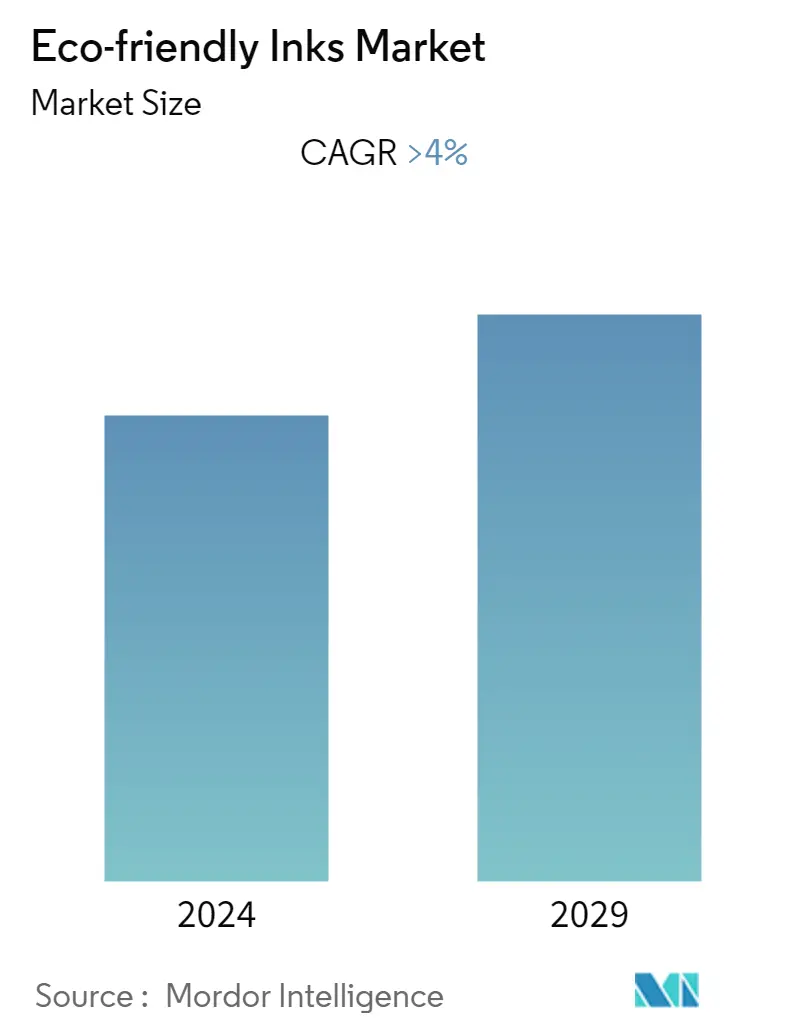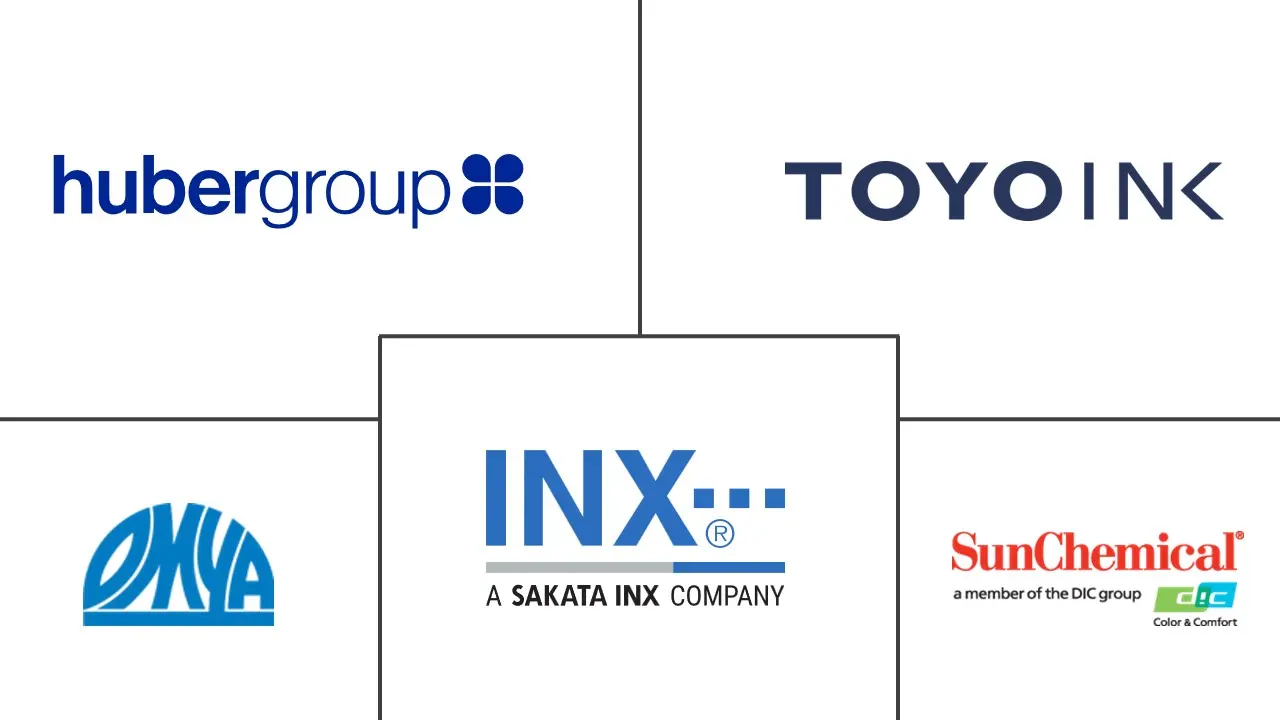Market Size of Eco-friendly Inks Industry

| Study Period | 2019 - 2029 |
| Base Year For Estimation | 2023 |
| CAGR | 4.00 % |
| Fastest Growing Market | Asia Pacific |
| Largest Market | North America |
| Market Concentration | Medium |
Major Players
*Disclaimer: Major Players sorted in no particular order |
Eco Friendly Ink Market Analysis
The global eco-friendly inks market is projected to register a CAGR of over 4% during the forecast period.
The COVID-19 pandemic had a negative effect on the world market for eco-friendly inks. Lockdowns and business closures resulted in supply chain disruption. However, the market is projected to grow steadily, owing to increased food industry activities in 2021.
- Over the short term, the growth in demand from the packaging industry and the growing concerns related to VOC emissions from conventional ink printing solutions are major factors driving the growth of the market studied.
- However, lack of exposure to low VOC inks and their advantages is a key factor anticipated to restrain the growth of the target industry over the forecast period.
- Nevertheless, increased attention toward the fashion industry and eco-friendly textile production is likely to create lucrative growth opportunities for the global market soon.
- Asia-Pacific dominated the market across the world, with the largest consumption from major countries like China, India, and other countries.
Eco Friendly Ink Industry Segmentation
The eco-friendly Printing inks consist of a pigment or pigments of the required color mixed with oil or varnish, majorly a black ink made from carbon blacks and thick linseed oil added with zero volatile organic compounds in it. The eco-friendly market is segmented by type, application, and geography. By type, the market is segmented into flint Ink, soy-based ink, UV ink, and other types. By application, the market is segmented into label and packaging, commercial printing, publication, and other applications. By geography, the market is segmented into Asia-Pacific, North America, Europe, South America, and Middle East and Africa. The report covers the market size and forecasts for the eco-friendly ink market in 15 countries across major regions. The report offers market size and forecasts for eco-friendly inks in volume (metric tons) for all the above segments.
| By Type | |
| Flint Ink | |
| Soy-based Ink | |
| UV Ink | |
| Other Types |
| By Application | |
| Label and Packaging | |
| Commercial Printing | |
| Publication | |
| Other Applications |
| By Geography | |||||||
| |||||||
| |||||||
| |||||||
| |||||||
|
Eco-friendly Inks Market Size Summary
The global eco-friendly inks market is anticipated to experience steady growth over the forecast period, driven by increasing demand from the packaging industry and heightened awareness of VOC emissions associated with traditional ink solutions. The market, which faced challenges due to the COVID-19 pandemic, is rebounding as activities in the food industry pick up. Eco-friendly inks, derived from vegetable and algae sources, are gaining traction due to their zero VOC content, making them suitable for applications such as food packaging. The rise in environmental consciousness, coupled with regulatory measures and resource scarcity, is further propelling the demand for sustainable packaging solutions. The fashion industry and eco-friendly textile production are also emerging as significant contributors to market expansion, offering new opportunities for growth.
The Asia-Pacific region leads the global market, with countries like China and India at the forefront due to their robust packaging and textile industries. China's position as a major manufacturing hub and exporter underscores its substantial demand for packaging materials, which in turn fuels the need for eco-friendly inks. The region's growing construction activities and increasing furniture demand also contribute to market growth. The rise of e-commerce and online food delivery services further boosts the need for sustainable packaging solutions. The market is characterized by a partially consolidated landscape, with key players such as Sun Chemical, Toyo Ink LLC, and INX International Ink Co. actively expanding their sustainable ink offerings to align with circular economy principles.
Eco-friendly Inks Market Size - Table of Contents
-
1. MARKET DYNAMICS
-
1.1 Drivers
-
1.1.1 Growth in Demand from Packaging Industry
-
1.1.2 Growing Concerns Related to VOC Emissions from Conventional Ink Printing Solutions
-
-
1.2 Restraints
-
1.2.1 Impact of COVID-19 Pandemic Outbreak
-
1.2.2 Other Restraints
-
-
1.3 Industry Value Chain Analysis
-
1.4 Porter's Five Forces Analysis
-
1.4.1 Threat of New Entrants
-
1.4.2 Bargaining Power of Buyers
-
1.4.3 Bargaining Power of Suppliers
-
1.4.4 Threat of Substitute Products
-
1.4.5 Degree of Competition
-
-
-
2. MARKET SEGMENTATION (market size in volume)
-
2.1 By Type
-
2.1.1 Flint Ink
-
2.1.2 Soy-based Ink
-
2.1.3 UV Ink
-
2.1.4 Other Types
-
-
2.2 By Application
-
2.2.1 Label and Packaging
-
2.2.2 Commercial Printing
-
2.2.3 Publication
-
2.2.4 Other Applications
-
-
2.3 By Geography
-
2.3.1 Asia-Pacific
-
2.3.1.1 China
-
2.3.1.2 India
-
2.3.1.3 Japan
-
2.3.1.4 South Korea
-
2.3.1.5 Rest of Asia-Pacific
-
-
2.3.2 North America
-
2.3.2.1 United States
-
2.3.2.2 Canada
-
2.3.2.3 Mexico
-
-
2.3.3 Europe
-
2.3.3.1 Germany
-
2.3.3.2 United Kingdom
-
2.3.3.3 France
-
2.3.3.4 Italy
-
2.3.3.5 Rest of Europe
-
-
2.3.4 South America
-
2.3.4.1 Brazil
-
2.3.4.2 Argentina
-
2.3.4.3 Rest of South America
-
-
2.3.5 Middle East and Africa
-
2.3.5.1 Saudi Arabia
-
2.3.5.2 South Africa
-
2.3.5.3 Rest of Middle East and Africa
-
-
-
Eco-friendly Inks Market Size FAQs
What is the current Eco-friendly Inks Market size?
The Eco-friendly Inks Market is projected to register a CAGR of greater than 4% during the forecast period (2024-2029)
Who are the key players in Eco-friendly Inks Market?
Toyo Ink LLC, INX International Ink Co., Hubergroup, Omya AG and Sun Chemical are the major companies operating in the Eco-friendly Inks Market.

